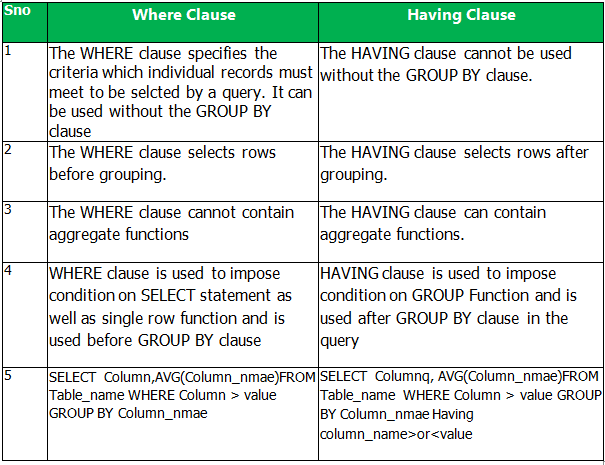A HAVING clause without a GROUP BY clause is valid and (arguably) useful syntax in Standard SQL. Because it operates on the table expression all-at-once as a set, so to speak, it only really makes sense to use aggregate functions. HAVING filters records that work on summarized GROUP BY.

Only the groups that meet the HAVING criteria will be returned. HAVING requires that a GROUP BY clause is present. WHERE and HAVING can be in the same query. Using having without group by. A query with a having clause should also have a group by clause.
If you omit group by , all the rows not excluded by the where clause return as a single group. Because no grouping is performed between the where and having clauses, they cannot act independently of each other. HAVING folgt immer dem GROUP BY , kann also nicht davor stehen.

Mit HAVING kann man die Ausgabe auf. When GROUP BY is not use there is an implicit single, aggregated group. One of these things are the GROUP BY and the less popular HAVING clauses. If there is no GROUP BY clause, the HAVING clause is applied to the entire result as a single group. It can, however, refer to constants.
Yes HAVING caluse can be use without GROUP BY. The GROUP BY Clause is used to group rows with same values. In this case, the server is free to choose any value from each group , so unless they are the.
It allows you to collapse a field into distinct values. Learn all you need to know in this tutorial. SELECT spalten_name, aggregations_funktion(spalten_name) FROM tabelleGROUP BY spalten_name HAVING aggregations_funktion(spalten_name) operator wert HAVING = WHERE für gruppierte Daten. If you use the GROUP BY clause without an aggregate function, the GROUP BY clause behaves like the DISTINCT operator. Wer sich also unschlüssig ist, welche Spalte bei HAVING anzugeben ist, der muss lediglich in die GROUP BY-Klausel schauen, denn genau diese Spalte und keine andere, muss auch bei HAVING stehen.
Alles andere führt zu einer Fehlermeldung. Ein genaues Beispiel zu dieser Problematik findet man im nachfolgenden Video Tutorial. This GROUP BY clause follows the.
For example, you can use the HAVING clause to answer questions like finding the number orders this month, this quarter, or this year that have total sales greater than 10K. After GROUP BY combines records, HAVING displays any records grouped by the GROUP BY clause that satisfy the conditions of the HAVING clause. HAVING is often coupled with the presence of the GROUP BY clause, although it is possible to have a HAVING clause without the GROUP BY clause.
SQL GROUP BY and DISTINCT.
Keine Kommentare:
Kommentar veröffentlichen
Hinweis: Nur ein Mitglied dieses Blogs kann Kommentare posten.